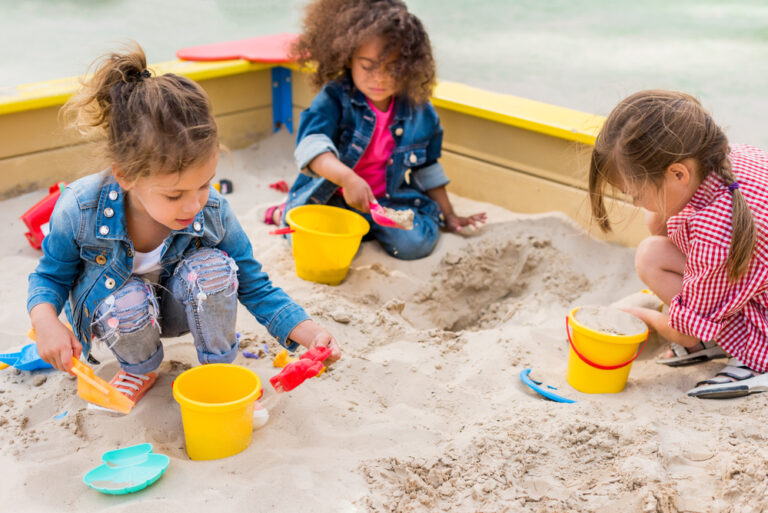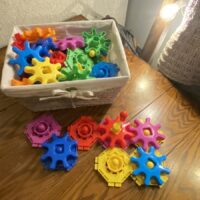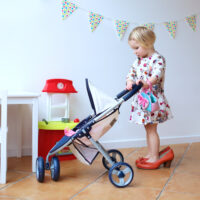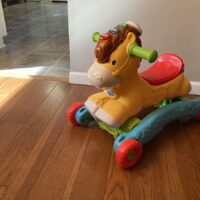Playing in the sand is not just a fun activity for your kids, it also helps them to improve their fine motor skills, engage their senses, and spur imaginative play. What you may not know is that if you purchase the wrong kind of sand, it could be detrimental to your child’s health. We researched the top options on the market, comparing attributes like ingredients, safety, and texture to ensure that you protect your child’s health, while still scoring the best price!
Best Sand for Sandbox
For the best price, PlaySand (50 pounds) and Classic Sand & Play (20 pounds) comes out at about $0.50/pound, Pure Organic (20 pounds) at $0.67/pound, BAHA Natural (20 pounds) at $0.57/pound.
Classic Sand and Play
We suggest purchasing this for a small playspace or in bulk to save the most money.
Why We Love It
Safety is paramount when it comes to our kids and Classic S&P strives to guarantee this outcome! This sand is another all-natural alternative that you don’t need to worry about if some lands in your child’s mouth. No worries about dust or harsh ingredients, just lots of fun!
Perfect for building castles, mountains, dinosaurs, and more! This product is moldable whether wet or dry and leaves very little mess for parents to clean up! Best of all, this company offers sand in all the colors of the rainbow! These options can be a bit more expensive, but they do engage the senses in a different way!
Why We Don’t Love It
This lands on the pricier end of our list when it comes to small quantity bags. Coming out at a little under two dollars a pound, this tends to be a better option for smaller boxes, tables, and trays. However, they offer bigger size varieties, and as well all know, buying in bulk is the way to save! If you purchase a bag that contains double the sand, it will cut the price in half. so make sure to check out your choices based on how much you need!
Considerations
- Safe for kids
- All-natural
- Non-toxic ingredients
- Moldable wet or dry
- Available in a range of colors
- Multiple size options
- Cheaper per pound for larger quantity bags
- Recommended for ages three and up
BAHA Natural
When you think of the beach, the first thing that comes to mind is the crystal blue waters crashing against a flawless, fine white sand seashore. If this is the type of sand that you were hoping for, then you are in luck! BAHA provides you with the closest thing to what’s found on the Bahamas oceanfront, without actually traveling out there!
Why We Love It
BAHA Natural is one of the safest sand varieties that you can find on the market! Silica, quartz, and dust are all things you want to avoid and this product checks all of those boxes! Moreover, we all know that young kids love to put things in their mouths and this sand is a safe choice if that occurs.
Furthermore, what good is sand if you can’t build a good sandcastle with it? The structure of the grains of sand makes for excellent building material, guaranteeing loads of fun! Not only that, but the smooth, fine texture makes certain that your kids don’t get scratched, which can happen if the sand is coarse.
Why We Don’t Love It
The only issue reported with this product is that due to the fine texture, it can stick to your kid’s hands more readily than other sand types. Therefore, make sure to prepare for a potentially bigger mess compared to other alternatives.
BAHA Natural is also a bit on the pricier end, costing a little over a dollar a pound, but when you consider the quality assurance and safety aspects of this product, it is worth the slightly higher price tag.
Considerations
- Non-toxic ingredients
- Safety tested for kids
- All-natural
- Great for building sandcastles
- Beautiful white color
PURE Organic Play Sand
It is all in the name; this environmentally friendly brand brings amusement in two, five, and twenty-pound bags!
Why We Love It
PURE Organic Play Sand provides an all-natural solution to your sand needs. Additionally, the texture of this option is ideal for building sandcastles!
Why We Don’t Love It
This play sand does have a bit more dust than other varieties, but the manufacturer recommends keeping it damp during playtime to help with this problem. Some people have reported it arriving with a bit of moisture in the bag, likely to limit the dust levels during transit, but if you are hoping for dry sand, it is something you should keep in mind.
PURE play sand is also another brand that lists silica and quartz in the ingredients, which can be harmful with enough exposure. However, they have taken the time to wash the sand, which does help reduce these ingredients although it doesn’t fully eliminate them.
Considerations
- All-natural
- Classic tan color
- Multiple size options
- Perfect for sandcastles
- Recommended for ages three and up
Quikrete
This all-natural play sand is a great choice for your sandbox and won’t cost you an arm and a leg!
Why We Love It
Quikrete passes through a stringent cleaning process. By doing this, it not only helps make the sand safe for your kids to play in, but it also gives it a fantastic texture. No one wants gritty sand and this is the quality of sand you would find at the beach!
Furthermore, this is the most cost-effective option on the market. At just over fifty cents a pound, it doesn’t take nearly as much to fill your sandbox and it guarantees a lot of fun!
Why We Don’t Love It
In years past, customers reported finding small rock fragments in some of the sandbags. This led the company to now practice a more in-depth filtering method to help prevent this issue from recurring.
Moreover, this option is a bit dustier than others, which is an attribute that can trigger asthma and allergy problems. If this is something that impacts your child, you may consider purchasing another play sand variety.
Considerations
- Smooth texture
- Classic tan color
- Affordable alternative
- Recommended for ages one and up
Best White Sand for Sandbox
The Palmetto (50 pounds) sand offers the best white sand for the price at about $0.56 per pound compared to the Sandtastik Sparkling White Play Sand sand (25 pounds) at about $1.12 per pound.
Sandtastik Sparkling White
This is another fantastic play sand that comes in a beautiful white color, exceeds safety standards, and allows your little one to explore their creative side!
Why We Love It
Sandtastik Sparkling White Play Sand is another really secure option that is free of any carcinogenic compounds and is asbestos-free! Moreover, it goes through stringent cleaning standards, limiting the dust that can trigger asthma flare-ups. At just under a dollar a pound, this option is in the medium-cost range, but it is worth it to ensure your child’s well-being!
Why We Don’t Love It
In years past, there have been reports of fleas in the bags of sand. These tiny crustaceans can be quite a nuisance, which is why it is always important to check any product you purchase upon delivery.
Considerations
- Safe for kids
- All-natural
- Non-toxic ingredients
- Smooth texture
- Beautiful white color
Palmetto
e!Why We Love It
Moms and dads agree that this is a great option for sensory play and the sand isn’t sticky like other brands, meaning easy cleanup! In addition, it’s also reported to dry better than other sand types after a heavy soaking, which is important if you want to prevent mold growth from occurring.
Palmetto has been filtered and washed to make certain that it is dust-free and has passed the safety standards of the US Consumer Product Safety Commission. It is an extremely cost-effective solution coming in at a little over fifty cents a pound!
In addition, white play sand tends to be easier to keep clean because debris is easier to spot compared to the tan varieties!
Why We Don’t Love It
Silica is listed as one of the ingredients of this sand. This mineral can cause a handful of health issues if exposed to it for long. While an adult may not have to worry about inhaling a lot of this, children tend to test the waters a bit more, putting things in their mouths and throwing items they shouldn’t and these actions could inadvertently cause irreparable damage to their lungs.
Considerations
- Affordable
- Less sticky
- Dries easily
- Beautiful white color
- Recommended for ages two and up
Sandbox Sand Compared
The table below compares only the recommended products on this page. A low or high Price means it is low or high compared to the other products listed. The Popularity Score reflects how often readers click on and buy the product. The Quality Score is our assessment of the overall performance and satisfaction with the product compared to others in the table.
| Sandtastik Sparkling White | 4.7 | - | 69.90 |
| Classic Sand and Play | 9.9 | 9.2 | 57.99 |
| BAHA Natural | 8.1 | 9.2 | 34.99 |
| Palmetto | 9.9 | 9.4 | 29.69 |
| Quikrete | 9.6 | 9.0 | 18.94 |
| PURE Organic Play Sand | 3.9 | 8.6 | - |
Things to Consider
Ingredients
Non-toxic ingredients are extremely important when it comes to any object that can land in your child’s mouth, eyes, and lungs. Materials to avoid are quartz and silica, which are known to include carcinogens and can cause lifelong health issues.
Dust
With over six million children being impacted by asthma each year, finding alternative sand for your backyard beach that won’t trigger an attack is imperative. Not only that, but dustier options can also prompt symptoms that mimic seasonal allergies.
Finally, a dusty sandbox means that good clean fun will likely not happen. Choosing a dust-free alternative allows your child to have a good time, without a lot of mess.
Mold-Ability
If you can’t build a sandcastle, then your child may not stick around for very long and they won’t receive the sensory benefits that come along with this type of play. Finding sand that has the consistency of granule sizes and shapes is key to making this happen.
What does that mean? You want to look for brands that practice meticulous cleaning of the sand because this not only kills bacteria and removes debris, but also smooths out the particles making for a more malleable material.
Cost
Depending on the size, shape, and depth of your sandbox, it could take a couple of hundred pounds of sand to bring the fun! This, in turn, means that it can also cost a pretty penny to make that happen. When you consider that you do have to replace the sand occasionally to keep things sanitary, you want to pick an affordable option, that doesn’t skimp on the health considerations.
Filtering
Whether the sand is natural or manufactured, there is the potential that other things can end up in the bag that you didn’t intend to bring into your backyard. You need to look for products that have no reports of rocks, debris, or bugs in the bags. If there are reports of this, look into whether or not the manufacturer has done something to remedy it or not. If they have, then they are likely a reputable source to purchase from because they care enough about their product to make changes and improvements.
Quantity
Are you filling a large sandbox, small sand table, or tray? Is this for a playground that won’t be covered? Is it going in your home or backyard? These are important questions to ask yourself before purchasing.
If you are filling a smaller space, then higher-quality options are likely your best bet. If you are putting it in a public space, then a low-grade, bulk, and more cost-effective solution might be best.
Color
This is a personal preference for most people. Sand normally comes in the classic tan color, but creme and white varieties are available as well. If you really want the kids to get creative, there are also brands that supply sand in all colors of the rainbow.
Keep in mind, when it comes to cleaning the sand, most bugs and debris will stand out against a white background, making for an easier pickup process if you choose these options.
Texture
This is another consideration that is based on your specific needs. Is this sand for learning, for building castles, or all of the above? Do you intend to keep it dry or will you let the kids make a bit of a mess by introducing water into the mix? Coarser sand doesn’t work as well for building compared to fine sand, but it brushes off a bit easier when it comes time to go inside. Coarser varieties can also irritate the skin a bit more. Overall, the finer the sand you buy, the more play-friendly it will be, and isn’t that the point of a sandbox?
FAQs – Safe Sand For Sandbox
What is the difference between the various types of sand on the market?
Natural sand that you find by the ocean and in the desert is composed of very small pieces of rock. It forms through the process of erosion. This basically means that the elements have been worn down by the wind, water, and weather in general. The sand is usually coarse in texture and can be made of a multitude of minerals including quartz, limestone, and mica to name a few. Depending on the origin of the play sand, certain types can contain compounds that are detrimental to your health.
Natural or manufactured play sand is much finer because it has gone through cleaning processes to help remove dust and debris, which in turn makes it safer for children.
What are the health impacts of certain types of sand?
All-purpose and contractor sand contains finite particles that when breathed in, can cause damage to your child’s developing lungs. Not only that but many types of sand that are not purposed for play are made of materials that are known carcinogens — namely, crystalline silica.
This is why it is so imperative to purchase play sand for your sandbox! Look for silica and quartz-free varieties that have been washed and then pressure washed. These steps ensure that the material is clean and that the sand particles are smooth.
The dust in the sand can also trigger asthma symptoms so looking for options that are free of this irritant can save you a lot of trouble.
How can I maintain the sand in my sandbox?
Rake the sand to remove any debris brought in by the weather, the wind, and animals. This process also allows you to check for bugs that may have snuck in. Unfortunately, this can happen whether or not you cover the box. That means it is important to do this PRIOR to playtime.
Moreover, while sand at the beach can stay wet all the time, play sand can grow mold so excess water can be a problem. If it does get wet, give it ample time to dry out before covering the bin.
As mentioned, if you cover your sandbox this can remedy a lot of issues and it guarantees that the sand will last longer. However, sand should be replaced at least twice a year, potentially more often, depending on how much it gets used.
How can I remove debris from my sandbox?
Raking after each use can save you a big project down the line. This activity can be cathartic for you at the same time! However, if the rake isn’t cutting it, run to the store and buy a colander, because you won’t want to use the one in your kitchen! This will allow you to sift out objects that don’t belong and let your sand last a bit longer!
How much sand do you need for a sandbox?
Let’s say the average square sandbox is 4 feet by 4 feet. If you want the sand to sit half a foot deep, you will need to purchase approximately 800 pounds of sand. This can add up quickly which is why finding an affordable option is important.
What if I don’t have a backyard for a sandbox?
Don’t let the lack of a yard deter you from providing your child with this exceptional activity! Sand tables and trays are both great options that can give your child a similar experience indoors! These options also tend to allow the sand to last longer. That’s because bugs, debris, and “gifts” left by wild animals are no longer a factor.
What are some of the educational benefits of having a sandbox?
As mentioned earlier, sensory play engages your child’s imagination! Playing in the sand also helps to fine-tune finger, hand, and wrist movements as they grab, shovel, and build with it. Additionally, it is a simple and subtle way to teach your child that things don’t last forever; those sandcastles will fade and that is okay!
More importantly, playing in a sandbox can also be an extremely easy activity to build on your child’s math skills. Purchase measuring containers and then have your kiddo fill each with different levels of sand. Ask them questions such as:
- Which one is bigger and which is smaller?
- How much is measured in each cup?
- What happens if you combine them? How much sand will that be?
This will allow your child to visually see an answer and understand the concept. In addition, you can also use sand to teach counting and shapes. It is always easier to educate a child when they are enjoying the activity and sand is an exceptional tool to make that happen.
This is just one of many sensory toys that can help your kids learn and grow!
What can you do with the sand other than build sandcastles?
Besides molding fun shapes, children can engage in treasure hunting, drawing, and playing with toys and trucks in the sand! It is also a great place for social skills to develop. Sharing, helping others, and working on vocabulary can all happen while having fun!












